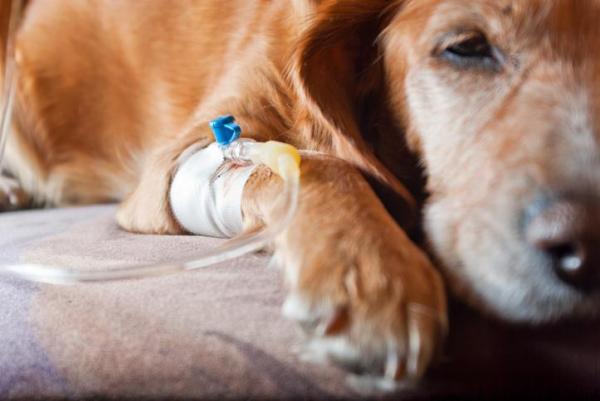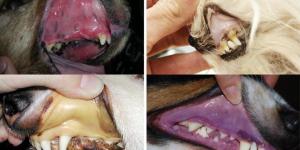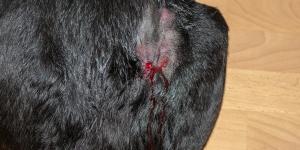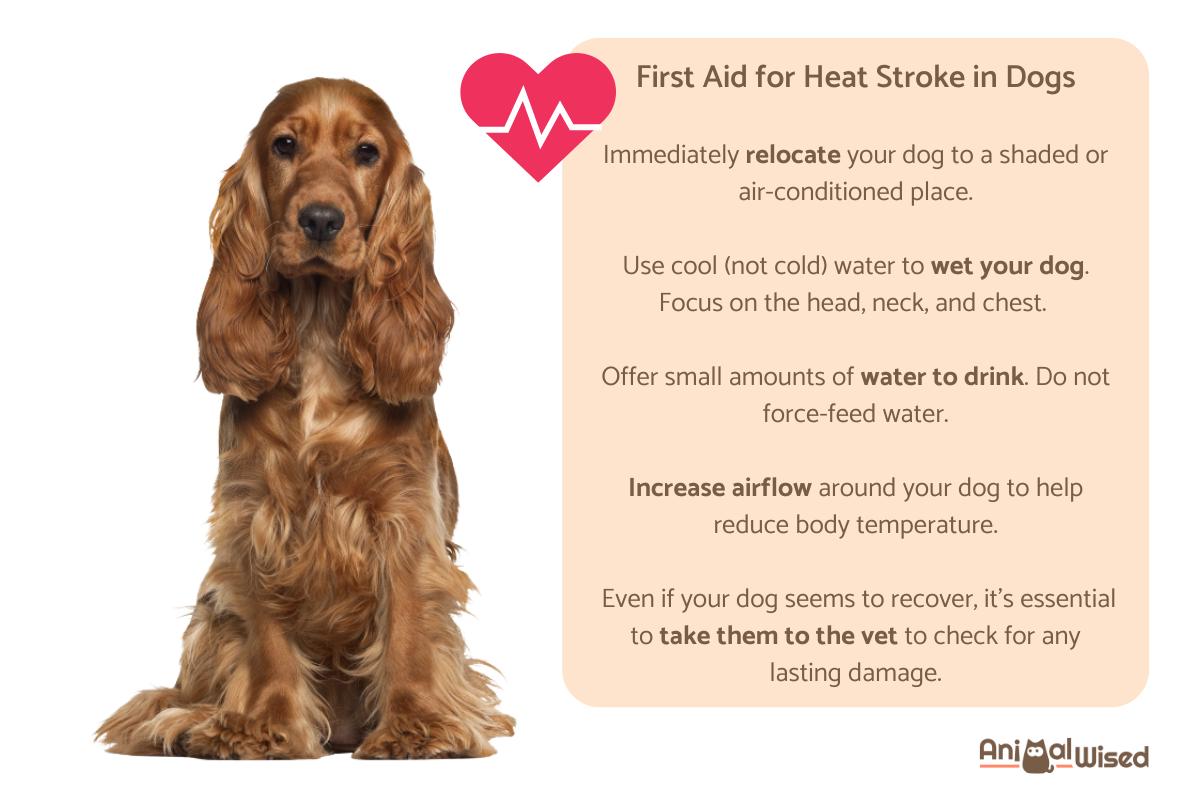What Are the Signs of Heat Stroke in a Dog?



See files for Dogs
Summer brings sunshine, barbeques, and plenty of outdoor fun for us humans. But for our dogs, the hot weather can pose a serious threat, heat stroke. This life-threatening condition can strike quickly, leaving dog owners scrambling to know what to do. By understanding heat stroke and taking the necessary precautions, you can ensure a safe and enjoyable summer for you and your canine companion.
This AnimalWised article dives into everything you need to know about heat stroke in dogs. We'll cover the early signs to watch for, what to do in an emergency, how to prevent it altogether, and explore some of the most common risk factors.
What is heat stroke in dogs?
Heat stroke, also known as hyperthermia, is a dangerous condition that occurs when a dog's body temperature rises too high, and it can no longer cool itself down. Unlike humans who sweat to regulate temperature, dogs rely primarily on panting. This, combined with certain risk factors, makes them more susceptible to overheating, especially during hot weather or strenuous activity.
Normally, a dog's body regulates temperature through panting. As they pant, moisture evaporates from their tongue and respiratory system, causing a cooling effect. However, when the environment is too hot or humid, panting becomes less effective. The dog's body temperature continues to rise, triggering a dangerous chain reaction.
- Because dogs primarily cool down by panting, the hotter they get, the less effective panting becomes.
- The body tries to compensate by increasing heart rate and breathing to circulate more blood and oxygen, hoping to cool down.
- Rapid panting can lead to dehydration. Dehydration thickens the blood, making circulation even more difficult and hindering cooling further.
- Prolonged high temperatures start to damage vital organs like the brain, kidneys, and liver, which can't function properly under such heat stress.
- In severe cases, the damage becomes so extensive that the dog can experience seizures or even slip into a coma.
But how do dogs regulate their body temperature in the first place? Our other article explains how do dogs keep cool and explores their natural cooling mechanisms to help you prevent heat stroke altogether.

Causes of heat stroke in dogs
Heat stroke can strike quickly and unexpectedly. Several factors contribute to this overheating, and understanding them is crucial to keeping your dog safe. Here's a deeper dive into the primary culprits:
- Extreme temperatures, especially when combined with high humidity, make it difficult for dogs to cool down. In humid environments, sweat evaporates less efficiently, further hindering a dog's natural cooling mechanism, panting.
- Exercising a dog excessively in hot weather can quickly lead to overheating. Adjust walks and playtime to cooler times of the day, and avoid intense activities during peak heat hours.
- If a dog doesn't have access to fresh water and shade on a hot day, heat stroke is a significant risk.
- Being left in a hot car. Even on a seemingly mild day, the temperature inside a car can rise rapidly, becoming deadly for a dog left unattended. Never leave your dog in a parked car, not even for a short errand.
- Dogs who haven't been gradually exposed to hot weather may be more susceptible to heat stroke during sudden temperature spikes. Introduce them to hotter temperatures slowly, allowing their bodies to adjust.
Heat stroke is a serious threat to all dogs, but senior pups can be especially vulnerable. This other article explores the warning signs of heat stroke in older dogs, helping you identify potential emergencies.
Risk factors for heat stroke in dogs
While any dog can be susceptible to heat stroke, certain risk factors make some dogs more vulnerable. Dog guardians should be aware of these risks to help prevent heat stroke as much as possible:
- Brachycephalic breeds: dogs with short snouts and flat faces, like pugs, bulldogs, and Shih Tzus, have a naturally compromised ability to pant. This makes them particularly susceptible to heat stroke, even in moderate temperatures.
- Puppies and senior dogs: both very young and older dogs have less efficient thermoregulatory systems, making them more vulnerable to overheating. Puppies haven't fully developed their ability to pant effectively, while older dogs might have underlying health conditions that can worsen with heat stress.
- Heart diseases: conditions like heart failure or heart murmurs can exacerbate symptoms during heat or intense exercise, leading to cough, fatigue, and fainting.
- Overweight and obesity: excess weight puts additional strain on a dog's body, increasing the risk of joint degeneration, heat stroke, and other health issues.
- Laryngeal paralysis: often hereditary and affecting mainly older dogs, this condition can cause severe respiratory distress, exercise intolerance, changes in barking, and coughing. Mild cases can be managed with medication, but severe cases may require surgery.
- Tracheal collapse: a chronic, irreversible disease that narrows the trachea, causing coughing, difficulty breathing, fainting, and wheezing. Management includes weight loss, medication, and sometimes surgery.
- Certain medications: can affect a dog's thermoregulation or exacerbate the effects of hot weather. Consult your veterinarian to understand if any medications your dog takes might increase their heat stroke risk.
- Thick fur: dogs with thick double coats can struggle to dissipate heat effectively, especially if not properly groomed for hot weather. Regular brushing and trimming can help.
It is important to note that, despite these specific risk factors, any dog can experience heat stroke due to intense exercise, lack of hydration, or excessive heat.
Signs and symptoms of heat stroke in dogs
Recognizing the signs of heat stroke in dogs is crucial for prompt action and preventing severe consequences such as organ damage or death. Here are the most common indicators of heat stroke in dogs:
Early warning signs:
- Excessive panting: this is a natural cooling mechanism for dogs, but panting that becomes rapid, excessive, and doesn't subside with rest could be a sign of overheating.
- Excessive drooling: heavy panting can lead to excessive drooling. However, if the drooling is thick, sticky, or accompanied by other symptoms, it becomes a cause for concern.
- Lethargy or weakness: a dog suffering from heat stroke might become lethargic, sluggish, or show signs of weakness. They might seem disinterested in their surroundings or refuse to move.
- Disorientation or confusion: heat stroke can affect a dog's mental state. They might appear confused, disoriented, stumble, or have difficulty following commands.
Signs of progression:
- Elevated body temperature: the most definitive sign of heat stroke is a rectal temperature exceeding 103°F (39.4°C). If you suspect heat stroke, take your dog's temperature rectally using a digital thermometer specifically designed for pets.
- Vomiting or diarrhea: heat stroke can cause digestive upset, leading to vomiting or diarrhea.
- Bright red gums: normally, a dog's gums should be pink. Bright red gums can indicate a dangerously high body temperature and heat stroke.
Severe heat stroke:
- Seizures or coma: in severe cases, heat stroke can lead to seizures or even coma. If you witness these symptoms, seek immediate veterinary attention.
If untreated, heat stroke can be fatal. Don't wait for all the signs to appear before acting. Early intervention is crucial for a dog's recovery. If you suspect heat stroke based on any combination of these symptoms, take immediate steps to cool your dog down and seek veterinary care.

First aid for heat stroke in dogs
Heat stroke is a life-threatening emergency for dogs. Recognizing the signs and taking immediate action can significantly improve your dog's chances of a full recovery. Here's a guide to first aid for heat troke in dogs:
- Move to a cooler and shaded area: get your dog out of the heat as quickly and safely as possible. Find a cool, shaded area or air-conditioned space.
- Hydrate: if your dog is conscious and able to drink, offer them cool water in small amounts. Don't force them to drink, as excessive water intake can lead to electrolyte imbalances.
- Wet your dog down gradually: use cool (not cold) water to wet your dog. Focus on areas with a lot of blood flow, like the belly, groin, armpits, and paws. You can use a wet towel, hose them down gently, or mist them with cool water. Avoid using ice water, as it can constrict blood vessels and hinder cooling.
- Fan the dog: create airflow around your dog using a fan or by gently swinging a towel.
- Avoid ice: do not use ice or very cold water, as this can constrict blood vessels and trap heat inside the body.
- Seek veterinary care: even if your dog seems to recover, it's essential to take them to the vet to check for any lasting damage. A veterinarian can assess the severity of the heat stroke, provide appropriate treatment, and monitor your dog's recovery.
Heat stroke is a veterinary emergency. While you are providing first aid, call your veterinarian immediately or have someone take you and your dog to the nearest animal hospital.

Treatment of heat stroke in dogs
The primary goal of treatment is to reduce the dog's body temperature and stabilize their condition. Here's how veterinarians typically handle heat stroke:
- The first step is to cool the dog down. This involves using cool (not cold) water, focusing on the head, neck, and chest. Ice is avoided as it can damage the skin and cause stress or anxiety.
- In severe cases, it may be necessary to open the dog's airway through intubation or, in emergencies, a tracheotomy. This ensures the dog receives adequate oxygen.
- Administering intravenous fluids is crucial. It helps improve blood flow, restores hydration, and balances electrolytes. This step is essential for stabilizing the dog's condition.
- Depending on the severity of the heat stroke, various medications might be used, including:
- Antibiotics: to prevent or treat any secondary infections.
- Antiemetics: to control vomiting and nausea.
- Intestinal protectors: to safeguard the digestive tract.
- Osmotic diuretics: to reduce swelling and manage fluid balance.
- Cardiac support: in cases of ventricular arrhythmias, drugs like lidocaine may be administered.
Often, the veterinarian will recommend hospitalization for continuous monitoring. This includes checking vital signs and blood pressure to ensure the dog remains stable. In extreme situations where multiple organs are affected, a condition known as Multiple Organ Dysfunction Syndrome (MODS) can occur. MODS is a serious, often fatal condition that requires intensive care.
The prognosis for heat stroke in dogs varies based on the severity and how quickly treatment is administered. Even with prompt care, some dogs may suffer from lasting effects such as brain damage and central nervous system (CNS) issues. The veterinarian will guide you on recognizing these potential issues and explain the necessary long-term care for your dog.

Prevention heat stroke in dogs
The good news is, with a proactive approach, you can significantly reduce your dog's risk of overheating and ensure a safe summer season. Here are some key preventive measures to remember:
- Ensure your dog has constant access to clean, cool water throughout the day. Carry a portable water bowl and water bottle on walks or outings.
- Adding ice cubes to your dog's water bowl can be a great way to keep it cool and entice them to drink more.
- Frozen Kong toys stuffed with healthy treats or homemade frozen yogurt licks can be a fun and hydrating way to keep your dog cool.
- Avoid walks or strenuous activity during the hottest part of the day (typically between 10 am and 4 pm). Opt for early morning or evening walks when the temperatures are cooler.
- Provide ample shade for your dog outdoors. Set up an umbrella, utilize the shade of trees on walks, or create a shaded area in your yard.
- Invest in a pressure-activated cooling mat for your dog to lie on indoors. These mats provide a cool and comfortable spot to escape the heat.
- If your dog isn't used to hot weather, gradually introduce them to warmer temperatures with shorter walks or outdoor playtime.
- Stick to well-shaded walking paths or grassy areas. Avoid hot asphalt or concrete surfaces that can burn your dog's paws. Consider using dog booties for added protection.
- Watch your dog for signs of discomfort like excessive panting, lethargy, or drooling. If they seem stressed, take them to a cool, shaded area and offer water.
- For dogs with thick fur, regular brushing can help remove excess fur that traps heat.
- Consider using a cooling vest for your dog during walks or outdoor activities.
- When traveling with your dog, bring a travel water bowl and ensure they have frequent water breaks.
Every second counts in these emergencies, but prevention is always better than cure. Our other article, how to keep dogs cool in summer, offers more information on proactive measures to keep your dog safe and happy during hot weather.

This article is purely informative. AnimalWised does not have the authority to prescribe any veterinary treatment or create a diagnosis. We invite you to take your pet to the veterinarian if they are suffering from any condition or pain.
If you want to read similar articles to What Are the Signs of Heat Stroke in a Dog?, we recommend you visit our First aid category.
- Johnson, S.I., McMichael, M., & White, G. (2006). Heatstroke in small animal medicine: a clinical practice review. Journal of Veterinary Emergency and Critical Care , 16(2), 112-119.
- Hemmelgarn, C., & Gannon, K. (2013). Heatstroke: thermoregulation, pathophysiology, and predisposing factors. Compendium (Yardley, PA), 35(7), E4-E4.
- Flournoy, W.S., Wohl, J.S., & Macintire, D.K. (2003). Heatstroke in dogs: pathophysiology and predisposing factors. Compendium , 25(6), 410-418.
- Epstein, Y., & Roberts, W.O. (2011). The pathophysiology of heat stroke: an integrative view of the final common pathway. Scandinavian journal of medicine & science in sports , 21(6), 742-748.
- Bruchim, Y., Loeb, E., Saragusty, J., & Aroch, I. (2009). Pathological findings in dogs with fatal heatstroke. Journal of comparative pathology , 140(2-3), 97-104.
- Bruchim, Y., Klement, E., Saragusty, J., Finkeilstein, E., Kass, P., & Aroch, I. (2006). Heat stroke in dogs: a retrospective study of 54 cases (1999–2004) and analysis of risk factors for death. Journal of veterinary internal medicine , 20(1), 38-46.










